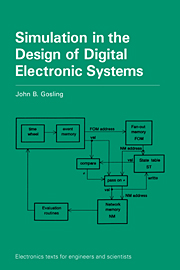Book contents
- Frontmatter
- Contents
- Preface
- 1 An introduction to the simulation of electronic systems
- 2 Electronic computer aided design (ECAD) systems
- 3 Design for testability
- 4 Exercising the design in simulation and test
- 5 Input/output of simulation and specification of models
- 6 Simulation algorithms
- 7 Models and model design
- 8 Timing verification
- 9 Fault simulation
- 10 Simulator features and extensions
- Appendix
- References
- Index
3 - Design for testability
Published online by Cambridge University Press: 05 June 2012
- Frontmatter
- Contents
- Preface
- 1 An introduction to the simulation of electronic systems
- 2 Electronic computer aided design (ECAD) systems
- 3 Design for testability
- 4 Exercising the design in simulation and test
- 5 Input/output of simulation and specification of models
- 6 Simulation algorithms
- 7 Models and model design
- 8 Timing verification
- 9 Fault simulation
- 10 Simulator features and extensions
- Appendix
- References
- Index
Summary
Cost of testing
Advantages and penalties
Most electronic system designers will never need to design a simulator. They will merely need to use one. An understanding of how the simulator works will enable it to be used more effectively, and avoids investing it with powers that it does not possess. However, most designers will have to write test sequences which the simulator will use to exercise the logic. They will also need to write programs for the equipment test rigs for exercising the real logic. These two activities overlap to some extent. However, checking that the system performs its specified functions is a design phase procedure and is used primarily in the simulator. Once the design is accepted as adequate it is necessary to check that any possible manufacturing fault can be detected during testing. The latter set of tests does not need to be ‘understandable’ in terms of the normal operation of the system since testing during manufacture is mainly on a go/no go basis. Developing and assessing the value of these tests is a major task and requires much further simulation. It is for this reason that the main chapters of this book begin with a look at the problems of writing test sequences.
The importance of careful testing of a design is illustrated by the costs involved. For the sake of example, let the cost of simulation be ‘one’ in whatever unit is appropriate.
- Type
- Chapter
- Information
- Simulation in the Design of Digital Electronic Systems , pp. 37 - 63Publisher: Cambridge University PressPrint publication year: 1993

